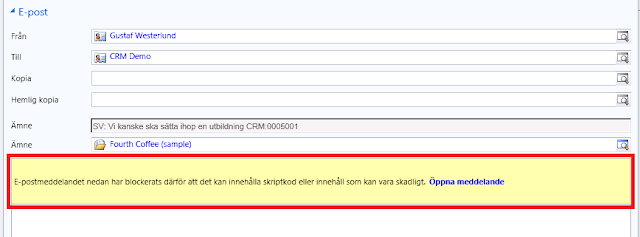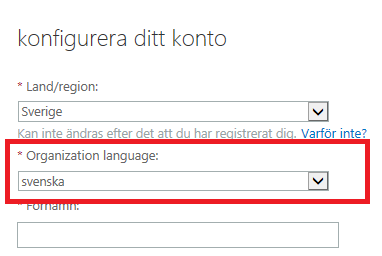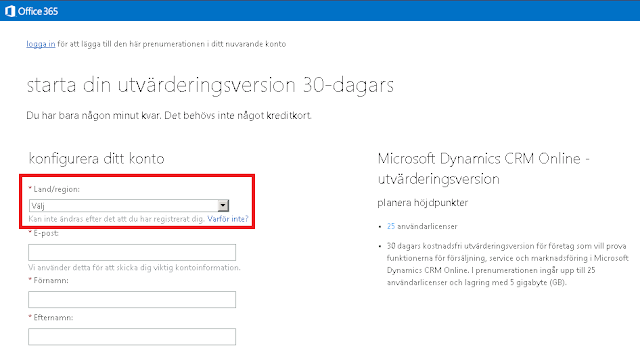
by Gustaf Westerlund | Jun 19, 2013
As some of you might be have noticed, when working with emails there are some rather nasty warnings about scripts in the emails. These take up quite a lot of realestate on the screen and many users would just like to hide them. But it is not so simple as there is no simple configuration to remove it.
This is what it looks like in a Swedish version of CRM:
A customer of ours at CRM-Konsulterna had this problem and we solved this for them. However, the solution is not kosher in the meaning that it is unsupported. It is also not very large so we thought we’d share it with the Community to the annoying problem go away until Microsoft fixes it, which they hopefuly will have done in Orion.
If you would like it, just head over to our website and download it: http://www.crmkonsulterna.se/Pages/EmailScriptWarningConcealer.aspx
What does it do? It is a small JavaScript that is executed in the onload of email which checks to see if the yellow Component exists and if so hides it. The problem is that the yellow box is not documented and hence might not work in the future, why we are very careful to check that it exists before
And is there no way of solving this in a supported way? Well, we did try to filter the email data with a plugin to take out all the parts that might cause the problems, but that was just to hard and too many emails were just unreadable.
Last but not least, I would like to give huge kudos to my colleague Konrad who put a great deal of effort into trying to solve this and coming up with this solution. If you havn’t alread checked out his blog, do so, you’ll find it here: http://konradviltersten.wordpress.com/
Gustaf Westerlund
MVP, CEO and owner at CRM-konsulterna AB
www.crmkonsulterna.se
by Gustaf Westerlund | Jun 13, 2013
About a year ago I took the CRM 2011 application exam (MB2-868) and passed it, but somehow it never got registered properly and I did not save the score report so I could not prove this, so today I retook it.
It is a very interesting certification. One of the hardest things is to Think about which update rollup (UR) it is written towards. I have Heard that many people have said that all certifications (for CRM anyway) should be written based on the RTM (Release to Market) version (=UR 0) but that also seems a bit strange as there have been some significant Changes made in UR6 (like multi series charts) and especially in UR12.
The sad thing is that there is no clear indication in the certification which version it is based on, so you do not know. I also do not know which questions I did not answer correctly, I only know that I got 90% correct which is rather funny considering I have held all the four application courses and also written my own MB2-868 Certification prep course of which more than 60% of all the attendees passed.
My recommendations to you are the following:
– Study explicitly for the application exam. Just working in the application is not enough.
– Try to learn the language used, find key Word like “all”, “should”, “never”. There are practice exam questions in the course material.
– Base the answers on RTM. I know how irrational this might be for you as you are not used to seeing CRM this way, but focus on passing the exam.
– Don’t be discouraged if you fail the first time. Most people fail the first time, especially the CRM 2011 Application exam as that is quite weird.
– Try to work a bit with all the parts of CRM. Try to use also the parts that often are never or seldom used like service contracts, facility management, complex service scheduling, Product catalog. Most people are quite used to the account, Contact, opportunity, lead, case part of CRM but there are surprisingly few questions about that. You will get a better understanding of what the parts are and how they are connected.
My recommendations to Microsoft:
– Make it clear which version the exam is for. RTM or URx. Just to be clear.
– Remove questions from the exam that are incorrect due to new features. It is extremely confusing.
– If someone leaves comments that are constructive after an exam, as I have done, also leaving my email address, I have not felt that there has been any response to that at all. If you have the ability to leave comments, do make sure that these are responded to, otherwise the function should be switched off.
– Peripherial features are a bit important, but the main processes are essential and these should be more prominent in the exam.
For all of those Writing the exam, I wish you the best of luck!
Today I also noticed that on Rockstar 365, I got the badge “#1 in the World”. That was a great honor!
http://rockstar365.com/crmgustaf
If you work with CRM, register and I bet you’ll beat me soon. Game on!
Gustaf Westerlund
MVP, CEO and owner at CRM-konsulterna AB
www.crmkonsulterna.se

by Gustaf Westerlund | Jun 5, 2013
In one of my recent postings I discussed the implicit settings that were set when choosing country, in a recent update, one of these implicit settings was converted to an explicit setting, namely the Organization Language.
 |
| The new field when provisioning CRM Orgs in CRM Online – Organization language |
An interesting thing about this field is that it cannot be selected to any language, but only to specific language. In Sweden, only to Swedish and English. In Switzerland, English, French, German or Italian. I think this is a good move forward but I don’t see any reason to why they are limiting the available languages. If a Chinese company wants to have chinese for an org in Sweden, why should that be a problem?
An interesting note is also that there seems to be a language hickup, “Organization Language” has not been properly translated to Swedish…
I have also not checked if the collation is connected to the language or the country, but I would expect it to be connected to the language. If anyone reading this has any input, please feel free to leave a comment.
Gustaf Westerlund
MVP, CEO and owner at CRM-konsulterna AB
www.crmkonsulterna.se
by Gustaf Westerlund | Jun 5, 2013
There have been some large and small stuff changing in the last few days in the way that new customers are being handled when the want to register for a trial.
If you go to the global site, http://www.microsoft.com/crm you will notice that there is a new “Get Started” orange rectangle on the right hand side. In this box, there is no “Start 30-day trial” but instead “TestDrive CRM”. This is rather interesting. If you choose this, the next screen will start asking you some questions, on what role you have, what size you company is, and where you work.
If you in this selection, choose 1-10, you will, and this might very well be changed, be show a page that welcomes you to download Business Contact Manager for Outlook. End of story. The logic being that no companies in the size of 1-10 could possibly be interested in Dynamics CRM. I find this a bit strange as I know for a fact that this is not true as I have many customers that have less than 10 users and still are very happy with their system.
The other interesting thing in the questions, is the role selector. The available roles are the following:
– Sale Representative
– Sales Manager
– Customer Care Representative
– Customer Care Manager
I find this list rather short, for instance lacking in roles such as CEO, CFO and CIO/IT-Manger or IT-Adminstrator.
But this is also only the first version so we might very well see updates to this very soon.
It seems a bit hard to find the original form for regisitering a trial org from the american site, but from the Swedish Microsoft CRM site it still works and this link should work: http://go.microsoft.com/fwlink/?LinkId=252780
Gustaf Westerlund
MVP, CEO and owner at CRM-konsulterna AB
www.crmkonsulterna.se

by Gustaf Westerlund | May 12, 2013
My last posting was regarding some important aspects of the email address that is entered when setting up a new CRM Online organization, you can read it here. In this posting I will be discussing some of the issues regarding the country field.
When registering for a new CRM Online Organization, you are shown a form and the top most field is a drop down allowing you to select which country you want. This might seem innocent enough, but do note the small text saying that this cannot be changed later and let me describe what you are actually setting in you future CRM and you might think a bit harder about this. The Picture below shows you the form in Swedish.
 |
| Swedish form for setting up a 30 day trial for CRM Online – the Country/Region field highlighted |
So what does this selection actually imply?
1. Which data center will be used (as indicated)
2. Which base language will be used
3. Which collation/sort order will be used
4. Which services can be used (as indicated)
5. Which tax regulations that are to be applied. (as indicated)
Let me describe each of these if further detail.
Data center
There are several data centers for Dynamics CRM around the World. Two in EMEA, two in North America, and two in South East Asia. If you select a country in EMEA, your organization will be hosted in one of the two data centers in EMEA. Exactly how this allocation is done is for me unclear and I do not think that Microsoft want to reveal this. What I have heard is that there is one data center in on the US east coast and one the the west coast and that there is no easy way to control which of these you will be getting, less than just setting up a couple of different trials until you happen to get one in the datacenter that you would like. I have also heard rumours that there might be some logic in Place that moves orgs from one data center to another to optimize usage. But I have not had any confirmation, denials or comments from Microsoft on this, so I do not think it is true until it is confirmed. I do know that orgs might temporarily be move between the data centers within a region for maintenance reasons or due to fail-overs. Ex. Choosing Swedish will make the org be hosted in EMEA, choosing USA will make the org be hosted in North America.
Language
Which base language will be used, is based on the country selected. For most countries this is simple as there is one dominant main language. If Sweden is chosen, Swedish is the base language. However, there are some other countries where this is a bit more complex, for Switzerland, it will simply be English, and I have not check other countries like Belgium.
Collation/Sort order
Related to the language is also the sort order or in more technical terms, collation. This is important as in many countries with special characters, the sort order is different than in normal English (iso-latin). For instance, in Swedish we have the characters “ÅÄÖ” at the end of the alphabet, these are not just accented A and O but fully qualified characters. The problem is that in the collation iso-latin, these are sorted as A and O (with accents) so a separate collation is used called Finnish-Swedish. There are lots of different collations for many different languages. When choosing the country “Sweden” the collation “Finnish-Swedish AS-CI” is also selected (AS-IS stands for Accent Sensitive, Case Insensitive).
Services
In some countries there are some additional services available to CRM that are not available in other countries. For instance, there are or have been some portal available for CRM Online available in North America that have not been made available in the rest of the World.
Tax and legal
Tax regulations are as many of you know, who have been around, very different between countries. Hence Microsoft need to know how billing is to be handled. There might also be other legal aspects of cloud systems. Some countries might require the cloud system supplier to inform the government of all the customers they have, hence the country selector might be very important from this aspect.
Conclusion
As you can see this one drop down has some quite wide implications. We have to be careful in this case. If a Swedish Company which has US-English as corporate language and hence want this as base language, but all users are based in Sweden and the sort order must be able to handle Swedish names correctly, how is this to be handled? Today, it can’t the solution would probably be to choose the Country “Great Britain”, but that would not give the right collation/sort order still. In that case, only partner hosted on on-premise solutions can currently handle this or this CRM Online organization has to be provisioned manually behind the doors by Microsoft Technicians some how. Let’s hope that Microsoft will soon add a function that will allow for advanced settings for the country selector, allowing for manual selection of each of these five parameters. Until then I hope this posting will guide you a bit and help you make and informed decision on which country to choose.
Gustaf Westerlund
MVP, CEO and owner at CRM-konsulterna AB
www.crmkonsulterna.se
by Gustaf Westerlund | Apr 26, 2013
As some of you might have noticed, that have been with this blog for a while, I am somewhat verbose, or in other words, I am not always very concise. This one of the reasons I have not joined Twitter as I have thought it a bit unfitting for my way of communication but I guess there comes a day when all sinners must confess to their sins and just adapt. So when my MVP colleague Jamie Miley sent me a Twitter invite, I finally subimitted to the inevitable fact that I just had to learn to Twitter, verbosity or not.
So, I have done this and you can now find me on @gustafcrm or https://twitter.com/crmgustaf if you would like to follow me. As usual, I will keep it strictly professional and CRMy so you won’t have to read any tweets about my kids and their soccer matches.
Gustaf Westerlund
MVP, CEO and owner at CRM-konsulterna AB
www.crmkonsulterna.se







Recent Comments